Desmond Elliott
MuSeD: A Multimodal Spanish Dataset for Sexism Detection in Social Media Videos
Apr 15, 2025Abstract:Sexism is generally defined as prejudice and discrimination based on sex or gender, affecting every sector of society, from social institutions to relationships and individual behavior. Social media platforms amplify the impact of sexism by conveying discriminatory content not only through text but also across multiple modalities, highlighting the critical need for a multimodal approach to the analysis of sexism online. With the rise of social media platforms where users share short videos, sexism is increasingly spreading through video content. Automatically detecting sexism in videos is a challenging task, as it requires analyzing the combination of verbal, audio, and visual elements to identify sexist content. In this study, (1) we introduce MuSeD, a new Multimodal Spanish dataset for Sexism Detection consisting of $\approx$ 11 hours of videos extracted from TikTok and BitChute; (2) we propose an innovative annotation framework for analyzing the contribution of textual and multimodal labels in the classification of sexist and non-sexist content; and (3) we evaluate a range of large language models (LLMs) and multimodal LLMs on the task of sexism detection. We find that visual information plays a key role in labeling sexist content for both humans and models. Models effectively detect explicit sexism; however, they struggle with implicit cases, such as stereotypes, instances where annotators also show low agreement. This highlights the inherent difficulty of the task, as identifying implicit sexism depends on the social and cultural context.
Kaleidoscope: In-language Exams for Massively Multilingual Vision Evaluation
Apr 09, 2025Abstract:The evaluation of vision-language models (VLMs) has mainly relied on English-language benchmarks, leaving significant gaps in both multilingual and multicultural coverage. While multilingual benchmarks have expanded, both in size and languages, many rely on translations of English datasets, failing to capture cultural nuances. In this work, we propose Kaleidoscope, as the most comprehensive exam benchmark to date for the multilingual evaluation of vision-language models. Kaleidoscope is a large-scale, in-language multimodal benchmark designed to evaluate VLMs across diverse languages and visual inputs. Kaleidoscope covers 18 languages and 14 different subjects, amounting to a total of 20,911 multiple-choice questions. Built through an open science collaboration with a diverse group of researchers worldwide, Kaleidoscope ensures linguistic and cultural authenticity. We evaluate top-performing multilingual vision-language models and find that they perform poorly on low-resource languages and in complex multimodal scenarios. Our results highlight the need for progress on culturally inclusive multimodal evaluation frameworks.
ImageChain: Advancing Sequential Image-to-Text Reasoning in Multimodal Large Language Models
Feb 26, 2025Abstract:Reasoning over sequences of images remains a challenge for multimodal large language models (MLLMs). While recent models incorporate multi-image data during pre-training, they still struggle to recognize sequential structures, often treating images independently. This work introduces ImageChain, a framework that enhances MLLMs with sequential reasoning capabilities over image data by modeling visual sequences as a multi-turn conversation. In ImageChain, images are interleaved with corresponding textual descriptions to form a controlled dialogue that explicitly captures temporal dependencies and narrative progression. Our method optimizes for the task of next-scene description, where the model generates a context-aware description of an upcoming scene based on preceding visual and textual cues. We demonstrate that our approach improves performance on the next-scene description task -- achieving an average improvement from 3.7% to 19% in SimRate, a metric that quantifies semantic similarity to human-annotated ground truths. Moreover, ImageChain achieves robust zero-shot out-of-domain performance in applications ranging from comics to robotics. Extensive experiments validate that instruction-tuning in a multimodal, multi-turn conversation design is key to bridging the gap between static image understanding and temporally-aware reasoning.
Can Community Notes Replace Professional Fact-Checkers?
Feb 19, 2025Abstract:Two commonly-employed strategies to combat the rise of misinformation on social media are (i) fact-checking by professional organisations and (ii) community moderation by platform users. Policy changes by Twitter/X and, more recently, Meta, signal a shift away from partnerships with fact-checking organisations and towards an increased reliance on crowdsourced community notes. However, the extent and nature of dependencies between fact-checking and helpful community notes remain unclear. To address these questions, we use language models to annotate a large corpus of Twitter/X community notes with attributes such as topic, cited sources, and whether they refute claims tied to broader misinformation narratives. Our analysis reveals that community notes cite fact-checking sources up to five times more than previously reported. Fact-checking is especially crucial for notes on posts linked to broader narratives, which are twice as likely to reference fact-checking sources compared to other sources. In conclusion, our results show that successful community moderation heavily relies on professional fact-checking.
How Do Multilingual Models Remember? Investigating Multilingual Factual Recall Mechanisms
Oct 18, 2024Abstract:Large Language Models (LLMs) store and retrieve vast amounts of factual knowledge acquired during pre-training. Prior research has localized and identified mechanisms behind knowledge recall; however, it has primarily focused on English monolingual models. The question of how these processes generalize to other languages and multilingual LLMs remains unexplored. In this paper, we address this gap by conducting a comprehensive analysis of two highly multilingual LLMs. We assess the extent to which previously identified components and mechanisms of factual recall in English apply to a multilingual context. Then, we examine when language plays a role in the recall process, uncovering evidence of language-independent and language-dependent mechanisms.
Tracking Universal Features Through Fine-Tuning and Model Merging
Oct 16, 2024Abstract:We study how features emerge, disappear, and persist across models fine-tuned on different domains of text. More specifically, we start from a base one-layer Transformer language model that is trained on a combination of the BabyLM corpus, and a collection of Python code from The Stack. This base model is adapted to two new domains of text: TinyStories, and the Lua programming language, respectively; and then these two models are merged using these two models using spherical linear interpolation. Our exploration aims to provide deeper insights into the stability and transformation of features across typical transfer-learning scenarios using small-scale models and sparse auto-encoders.
Classification of Radiological Text in Small and Imbalanced Datasets in a Non-English Language
Sep 30, 2024

Abstract:Natural language processing (NLP) in the medical domain can underperform in real-world applications involving small datasets in a non-English language with few labeled samples and imbalanced classes. There is yet no consensus on how to approach this problem. We evaluated a set of NLP models including BERT-like transformers, few-shot learning with sentence transformers (SetFit), and prompted large language models (LLM), using three datasets of radiology reports on magnetic resonance images of epilepsy patients in Danish, a low-resource language. Our results indicate that BERT-like models pretrained in the target domain of radiology reports currently offer the optimal performances for this scenario. Notably, the SetFit and LLM models underperformed compared to BERT-like models, with LLM performing the worst. Importantly, none of the models investigated was sufficiently accurate to allow for text classification without any supervision. However, they show potential for data filtering, which could reduce the amount of manual labeling required.
CRAFT Your Dataset: Task-Specific Synthetic Dataset Generation Through Corpus Retrieval and Augmentation
Sep 03, 2024Abstract:Building high-quality datasets for specialized tasks is a time-consuming and resource-intensive process that often requires specialized domain knowledge. We propose Corpus Retrieval and Augmentation for Fine-Tuning (CRAFT), a method for generating synthetic datasets, given a small number of user-written few-shots that demonstrate the task to be performed. Given the few-shot examples, we use large-scale public web-crawled corpora and similarity-based document retrieval to find other relevant human-written documents. Lastly, instruction-tuned large language models (LLMs) augment the retrieved documents into custom-formatted task samples, which then can be used for fine-tuning. We demonstrate that CRAFT can efficiently generate large-scale task-specific training datasets for four diverse tasks: biology question-answering (QA), medicine QA and commonsense QA as well as summarization. Our experiments show that CRAFT-based models outperform or achieve comparable performance to general LLMs for QA tasks, while CRAFT-based summarization models outperform models trained on human-curated data by 46 preference points.
LLMs instead of Human Judges? A Large Scale Empirical Study across 20 NLP Evaluation Tasks
Jun 26, 2024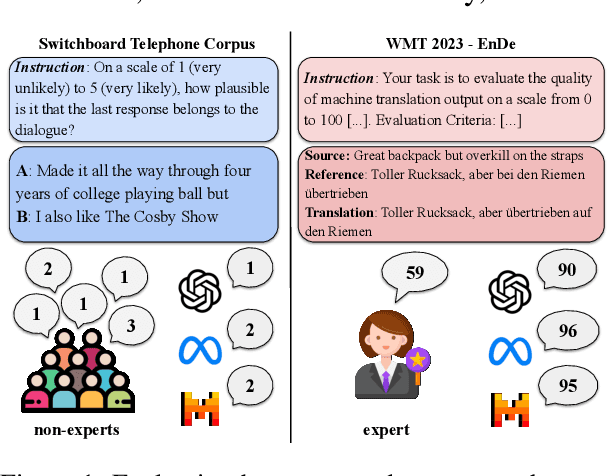
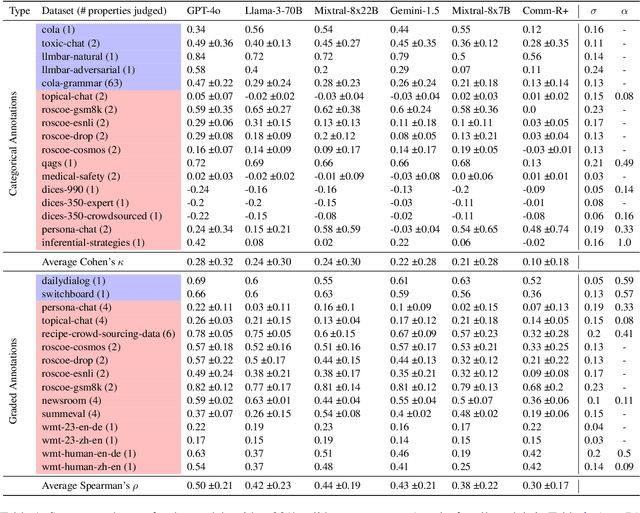
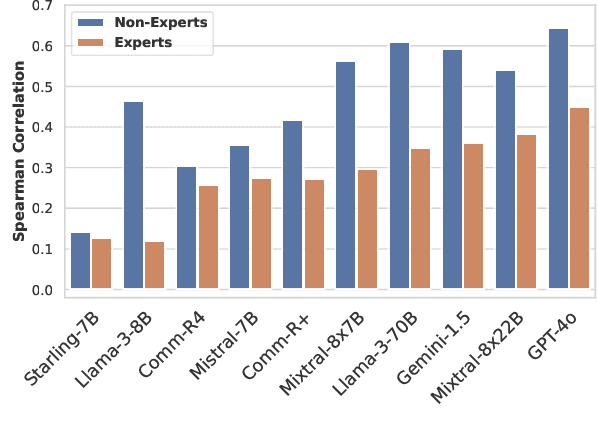
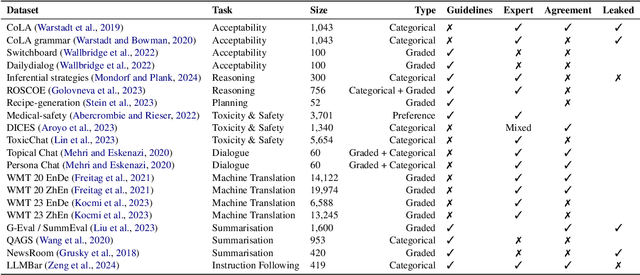
Abstract:There is an increasing trend towards evaluating NLP models with LLM-generated judgments instead of human judgments. In the absence of a comparison against human data, this raises concerns about the validity of these evaluations; in case they are conducted with proprietary models, this also raises concerns over reproducibility. We provide JUDGE-BENCH, a collection of 20 NLP datasets with human annotations, and comprehensively evaluate 11 current LLMs, covering both open-weight and proprietary models, for their ability to replicate the annotations. Our evaluations show that each LLM exhibits a large variance across datasets in its correlation to human judgments. We conclude that LLMs are not yet ready to systematically replace human judges in NLP.
FoodieQA: A Multimodal Dataset for Fine-Grained Understanding of Chinese Food Culture
Jun 16, 2024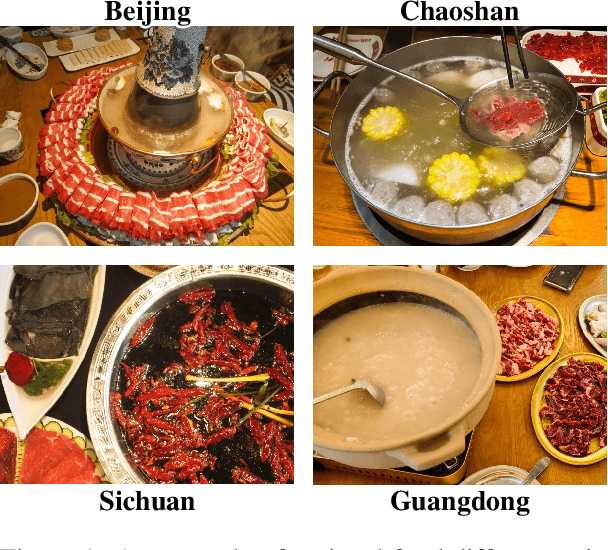

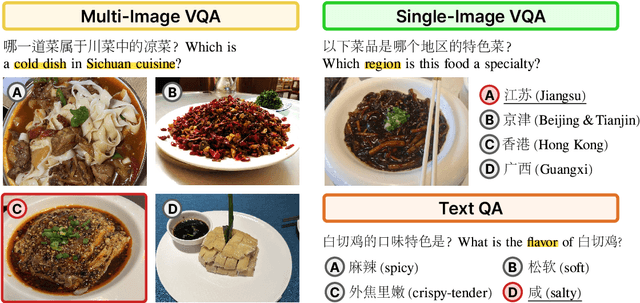

Abstract:Food is a rich and varied dimension of cultural heritage, crucial to both individuals and social groups. To bridge the gap in the literature on the often-overlooked regional diversity in this domain, we introduce FoodieQA, a manually curated, fine-grained image-text dataset capturing the intricate features of food cultures across various regions in China. We evaluate vision-language Models (VLMs) and large language models (LLMs) on newly collected, unseen food images and corresponding questions. FoodieQA comprises three multiple-choice question-answering tasks where models need to answer questions based on multiple images, a single image, and text-only descriptions, respectively. While LLMs excel at text-based question answering, surpassing human accuracy, the open-sourced VLMs still fall short by 41\% on multi-image and 21\% on single-image VQA tasks, although closed-weights models perform closer to human levels (within 10\%). Our findings highlight that understanding food and its cultural implications remains a challenging and under-explored direction.
 Add to Chrome
Add to Chrome Add to Firefox
Add to Firefox Add to Edge
Add to Edge